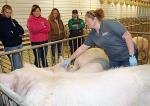COLUMBIA, Mo. – Beef herd owners would be shocked to learn they’d lost 25 percent of cow pregnancies in two weeks. It happens all the time. And owners never know it.
“Huge losses occur before farmers know their cows are pregnant,” says Mike Smith, University of Missouri animal scientist. “Many losses occur before the cows know they are pregnant.”
Pregnancy checks in University of Missouri research herds show that three days after breeding, 95 percent of all cows bred are with calf. But 14 to 16 days later pregnancies drop to 70 percent. Early embryonic death loss cuts calf crops.
Late embryonic death pushes losses higher. By day 30, pregnancy rates have dropped to 65 percent. Another five to 10 percent can be lost later in gestation.
Preventing pregnancy losses offers profit potential to the beef industry. That research continues at the MU College of Agriculture, Food and Natural Resources.
New tools developed at MU allow early detection of pregnancies.
Smith, professor of beef reproduction, will report his work at a field day, Sept. 17 at the MU Thompson Farm in northwestern Grundy County, west of Spickard, Mo.
Also, he will tell herd owners steps they can take to reduce embryonic losses.
“Genetic defects cause one-third of early losses. Those losses clear birth defects and genetic abnormalities,” Smith says. “That leaves two-thirds of losses to stress and other factors in cows.”
Herd managers can reduce stress.
“We don’t know what causes all of these early embryonic losses,” Smith says. “But there are ways to save more calves through management.”
Transportation and heat stress cause losses. Loading cows on a truck and moving them after breeding creates stress. Timing and method of moves affect loss rates. Heat stresses come from the sun and from toxic endophyte-infected fescue grass.
Smith studied embryonic death loss while earning his Ph.D. He did the research in the 1970s at the Texas Agricultural Experiment Station, Beeville, Texas.
Until recently, early pregnancy detection was difficult. New tools were developed by MU scientists in the Food for the 21st Century (F21C) program. They use hormonal assays to detect protein signals from the cow’s placenta. Also, new high-resolution ultrasound monitors show early embryos.
“Earlier, we didn’t have tools to do this basic work,” Smith says.
Now, Smith returns to his studies in beef herds at Fort Keogh, Mont., MU Thompson Farm and in Brazil. Study of pregnancy loss requires large herds of cows to get significant results.
With fixed-time artificial insemination, developed at MU Thompson Farm, herd owners regularly achieve 65 percent of cows pregnant at day 90 after breeding. With timed AI, all cows in a herd are bred on the first day of breeding season. “When you get over 70 percent pregnant, that is phenomenal considering embryonic losses,” Smith says.
Basic research on maternal hormones was sponsored by F21C, funded by the Missouri legislature. Smith’s students aid in the research. Results are conveyed to farmers through field days and MU Extension.
MU received a five-year grant to study genetic defects affecting early embryonic losses in heifers.
The Sept. 17 field day will show other studies from the MU herd. That includes the new management and marketing program, “Quality Beef by the Numbers.” Enrolled herd owners can profit from better management.
Farmers attending the free event get a first look at new methods to breed cows. Registration starts at 9:30 a.m. The day ends with wagon tours by 3 p.m.
To reach Thompson Farm, go to the end of Highway C, seven miles west of Highway 65 at Spickard. Also, the farm can be reached from Highway A off of Highway 136 from the north, or off of Highway 65 north of Trenton.
MU holds annual field days at its farms across the state.
Read more http://extension.missouri.edu/news/DisplayStory.aspx?N=1968





